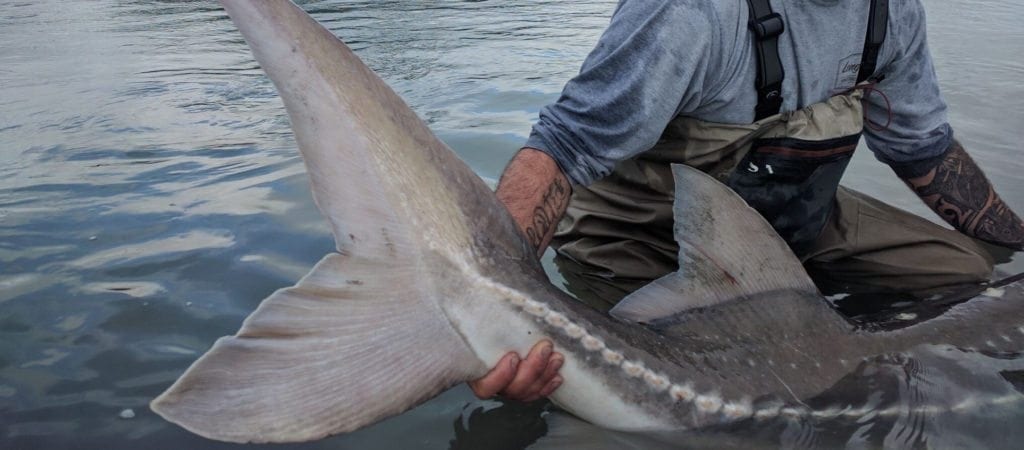FRASER RIVER STURGEON FISHING
The Fraser River White Sturgeon is North America’s largest freshwater game fish. White Sturgeon are among the largest and longest-lived of the many species and of freshwater fish in North America, sometimes attaining weights of up to 1,000lbs. The Fraser River is home to the healthiest population of these magnificent fish in the world. Fishing for Fraser River Sturgeon is a game of patience, when hooked the power and brute force these fish exert is truly unbelievable, often jumping clear of the water. Sturgeon have been known to bring grown men to their knees (I have seen it happen).
White Sturgeon is at the top of the Fraser River food chain, and one of the few year-round resident species of fish in the lower Fraser River. Sturgeon fishing has increased in popularity over the recent years as many anglers have heard about the enormous sizes and want to catch their own monster. Some specimens during the season will reach 10 to 13 ft. in length and will weigh in at 500 to 1200 lbs. These are truly spectacular specimens, the apex of their kind. Most of the Sturgeon that are caught by sports anglers will range in size from about 3ft. to 7ft. and weigh between 20 and 250lbs.
The Fraser River has one of the healthiest populations of White Sturgeon. It is known the world over, that if you want to catch trophy White Sturgeon, you come to the Fraser River.
White Sturgeon Facts
White Sturgeon are survivors from the dinosaur age and white sturgeons are the ones you will find in the Fraser River. White sturgeon are among the largest and longest-lived of the many sturgeon species and of freshwater fish in North America. Amazingly, sturgeon have remained virtually unchanged since they first appeared in the fossil record 175 million years ago. White sturgeon are at the top of the Fraser River food chain and one of the few year-round resident species of fish.
The White Sturgeon’s Appearance
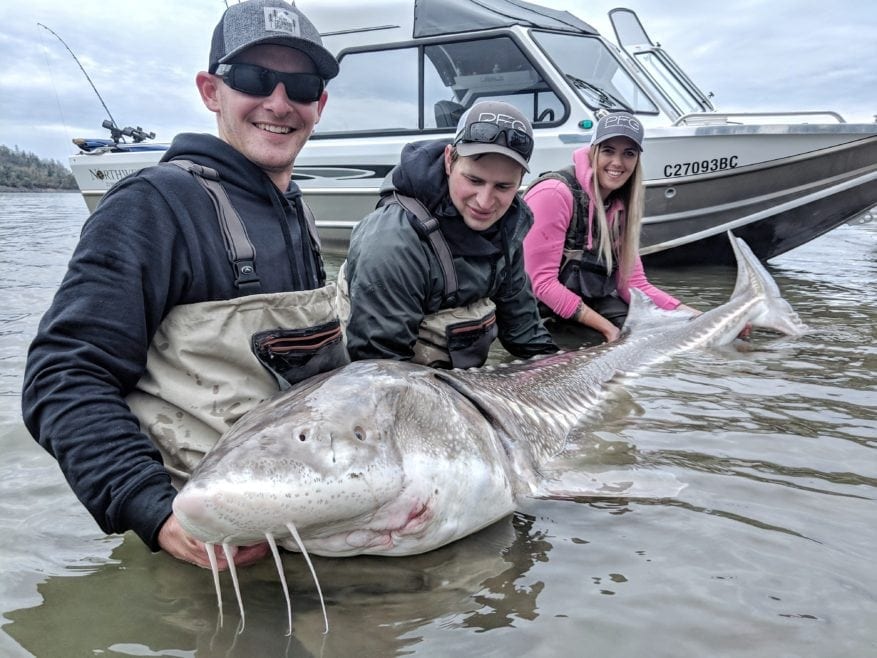 The white sturgeon’s overall body shape is long and cylindrical with the color on the back a brown or grey and the color on the bellies a gleaming white. Instead of fish scales, the sturgeon body is covered with 5 rows of bony plates called scutes. White Sturgeon have an exoskeleton so the only bones in their body are their skull and the bony plates. Their spine is made of a coiled cartilage called a monochord. The unique feature of the white sturgeon is it’s flattened nose or rostrum. On the underside of the rostrum just in front of the mouth are four barbels or fleshy whisker-like projections that are used as sensory organs to detect scent and food in the murky water at the bottom of the river. White Sturgeon have ampullae of Lorenzini which are special sensing organs, called electroreceptors, which form a network of jelly-filled pores. This allows them to detect the heartbeat of their prey. To further hone in on their prey, they also have chemical receptors inside their heads to detect fish in distress. White sturgeon can attain lengths in excess of six meters, weights of over 600 kilograms, and can live for over 150 years. White Sturgeon measuring 7-to-12 feet long is a common size for adult sturgeons, and some varieties can get to over 18-feet-long
The white sturgeon’s overall body shape is long and cylindrical with the color on the back a brown or grey and the color on the bellies a gleaming white. Instead of fish scales, the sturgeon body is covered with 5 rows of bony plates called scutes. White Sturgeon have an exoskeleton so the only bones in their body are their skull and the bony plates. Their spine is made of a coiled cartilage called a monochord. The unique feature of the white sturgeon is it’s flattened nose or rostrum. On the underside of the rostrum just in front of the mouth are four barbels or fleshy whisker-like projections that are used as sensory organs to detect scent and food in the murky water at the bottom of the river. White Sturgeon have ampullae of Lorenzini which are special sensing organs, called electroreceptors, which form a network of jelly-filled pores. This allows them to detect the heartbeat of their prey. To further hone in on their prey, they also have chemical receptors inside their heads to detect fish in distress. White sturgeon can attain lengths in excess of six meters, weights of over 600 kilograms, and can live for over 150 years. White Sturgeon measuring 7-to-12 feet long is a common size for adult sturgeons, and some varieties can get to over 18-feet-long
The Sturgeon Lifespan
White Sturgeon have a very long lifespan with some in BC over 100 years old. White Sturgeon tend to grow slowly and are not ready to spawn until the females are over 18 years of age and males are at least 14 years of age. However, they are able to spawn multiple times over a lifetime. White Sturgeon spawn by using the broadcast spawning method where the male and female release sperm and eggs together in the water current. The fertilized eggs become sticky and attach to the river bottom where they mature into larvae in 8-15 days and then spend another 20-30 days nestled in the river bed until they metamorphose into free swimming young sturgeon
Largest White Sturgeon
A 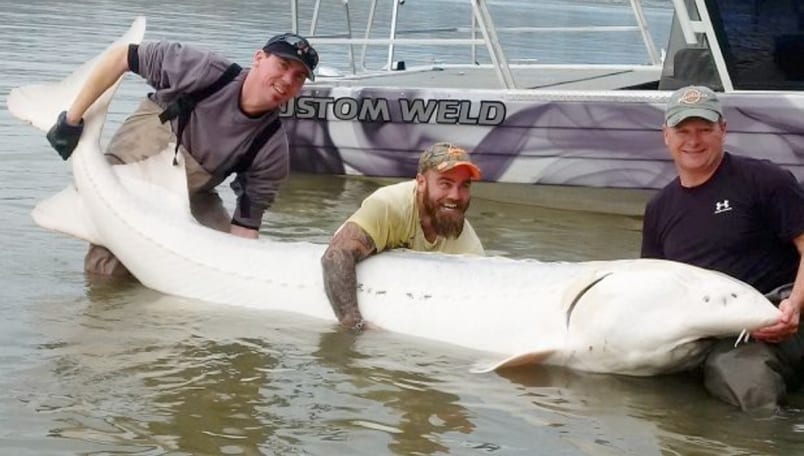 Canadian fisherman landed a rare and enormous albino sturgeon that very well might be a world record with the fish measuring an incredible 11 feet, two inches and weighing an estimated 1,000 lbs or more.
Canadian fisherman landed a rare and enormous albino sturgeon that very well might be a world record with the fish measuring an incredible 11 feet, two inches and weighing an estimated 1,000 lbs or more.
After taking photographs at the shoreline, Helmer released the albino sturgeon, leaving him with amazing memories.
Conservation
With the high number of anglers partaking in this fishery, it’s very important that the fish have been managed properly to minimize effect and make sure that the fishery is sustainable. The Ministry of Forests, Lands and Natural Resource Operations (with assistance in the Fraser River Sturgeon Conservation Society, Fraser Valley Angling Guides Association, Recreational Sturgeon Anglers of BC, and Fisheries and Oceans Canada) has created guidelines for catching and correctly releasing sturgeon. Anybody who fishes for white sturgeon on the Lower or Middle Fraser River is invited to read and follow the Guidelines for Angling White Sturgeon at BC.
The Fraser River Sturgeon Conservation Society (with assistance in the Habitat Conservation Trust Foundation, Province of B.C., Fisheries and Oceans Canada, along with the Rick Hansen Foundation) has also put together a movie which covers those recommendations in more detail. Strategies for Angling Sturgeon at BC.
Fishing for White Sturgeon
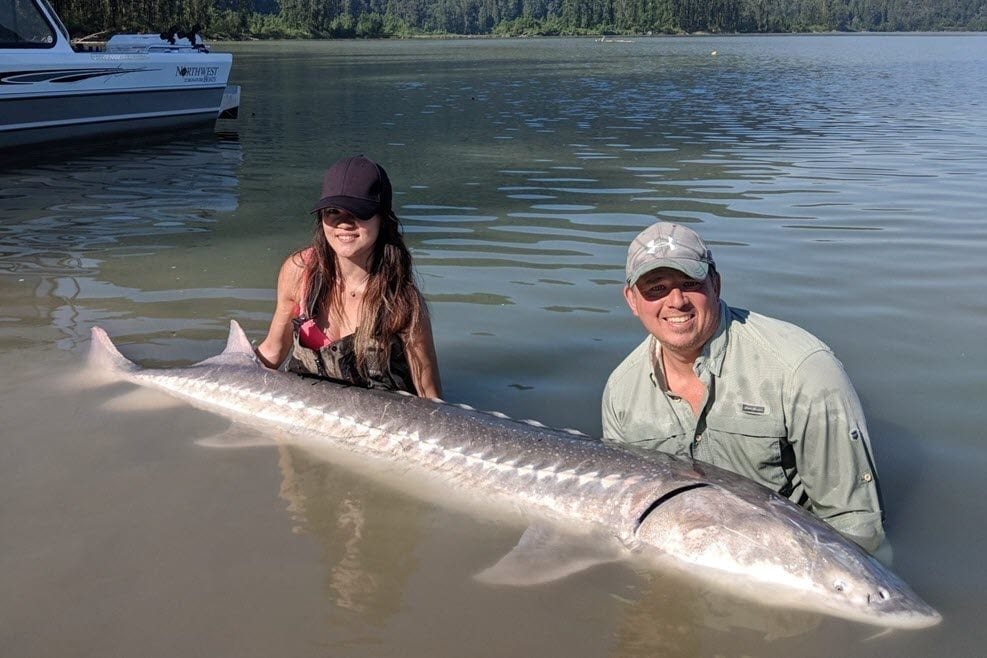 The white sturgeon has quickly become a popular game fish, pursued by anglers from all around the world. When they are caught they put on quite a show and often leap into the air. There are many white sturgeon residing in the Fraser River and sturgeon fishing is available year round but prime season is between March and November. There are two major feeding periods when sturgeon fishing is at its best; April- June and September- November. During the winter months most fish being caught are smaller (2 to 4 feet is average). Successfully catching sturgeon involves finding them. There are two ways to fish for white sturgeon; from a boat or from shore. Rods and reels used are different for each method. White sturgeon for the most part, tend to concentrate in holes, seams or drop-offs within the river bottom. They also enjoy hanging out in back channels of the Fraser.
The white sturgeon has quickly become a popular game fish, pursued by anglers from all around the world. When they are caught they put on quite a show and often leap into the air. There are many white sturgeon residing in the Fraser River and sturgeon fishing is available year round but prime season is between March and November. There are two major feeding periods when sturgeon fishing is at its best; April- June and September- November. During the winter months most fish being caught are smaller (2 to 4 feet is average). Successfully catching sturgeon involves finding them. There are two ways to fish for white sturgeon; from a boat or from shore. Rods and reels used are different for each method. White sturgeon for the most part, tend to concentrate in holes, seams or drop-offs within the river bottom. They also enjoy hanging out in back channels of the Fraser.
Fishing a variety of baits is the key to finding what’s working best that day. Using a bait that is present in the area will produce larger fish. Some baits that are used are eulichans, lamprey, ditch eels, headless fin fish, dew worms, Salmon gills and salmon roe. It’s best to have a variety on hand when trying to allure some sturgeon.
If you are interested in catching some white sturgeon, I over 37 years of experience fishing the Fraser River and can accommodate all levels of fishing experience. Contact me for more details about our Fraser River fishing trips.
Best Time of Year to Fish for Fraser River Sturgeon

Fishing for Sturgeon should be on every angler’s bucket list, and the Fraser River is home to one of the largest populations of Sturgeon . Fraser River Sturgeon fishing is known to be the best in the world and no other river can compare . It is possible to fish for them yourself with some success, but hiring a local fishing guide will ensure you spend more time fishing than boating. The Fraser is a large river almost 1000 miles long and Sturgeon can be found through out most of it’s length, but most fishing for sturgeon is done from the town of Hope down and into the tidal section. A local fishing guide will know the area well and bring you to the best spots for success. Sturgeon are notoriously picky with their food preference, which can change daily, a quality guide is usually in the loop and knows what bait is working best at tat time
Sturgeon fishing season on the Fraser River is open year round but certain times of the year are better than others. Luckily, with sturgeon, the optimal fishing season is long and between March to November. The peak season is characterized by average daily catches numbering between 10 to 20 sturgeon all ranging from 3 to 8 feet and sometimes bigger
May is a great month for sturgeon fishing as is coincides with the Eulachon migration. Which is the first feast of the season after a winter of slim pickings. Summer fishing between the months of June to September is also very enjoyable. Nothing beats the warm weather and beautiful scenery and it’s generally a great time of year to be on a boat. However, Fall is prime time for Sturgeon fishing as they are fattening up for winters famine.
Best Time of Day to Fish for Sturgeon
When fishing for Sturgeon, the best time of day will often be in the morning before there is a lot of fishing pressure on the river and then it will taper off from late morning to early afternoon. That being said, fishing is often hot all day long.
Fraser River Sturgeon Fishing Tips
We employ the latest technology in fish finders, so we can actually see the sturgeon on the bottom. I would say Sturgeon fishing is more akin to hunting then fishing. They move around quite a bit, so finding the fish is half the challenge. Once located , the hooks are baited and cast into the river, and the game begins. There are no norms when it comes to sturgeon fishing, on one day and off the next. Every day is a new day, with different results. Knowing which baits to use at certain times means the difference between sore arms and no fish.
Sturgeon are extremely sensitive when taking the bait. If they feel something is even slightly not right, they will spit the bait in a half a second. Once hooked however, the Sturgeon provide a fight like no other fish. As the season progresses, and the water warms a bit from its frigid winter temperature, Sturgeon start to fight harder. Clearing the water soon after being hooked is common place. Line in the 100 lb to 150 lb class is typical, with a drag set to match these lines, one could almost stop a small car from driving away.
Fighting a Sturgeon is a like a painful amusement ride, you just hang on and hope for the best. The fight can last anywhere from 15 minutes to a couple hours. That’s a couple hours of pulling on a rod with all your strength, which can be taxing to even the fittest of angler.
Best Bait for River Sturgeon
If you're a beginner, after reading this you should have a basic idea of what baits to use and when. It will still require a little bit of research on your part so this is a basic generalization.
The first bait and the last bait of the season, are salmon eggs and lamprey. I use these baits in October, November and throughout the winter until April.
Single eggs seem to work best. I take the eggs and tie them in a sack about the size of a toonie. I use plain old pantyhose for the material. To put these on the hook, I just simply pierce the bag with the hook and you're ready to rock. Keep in mind eggs will work all season, as will lamprey. It's a great bait to have on at least one rod on a daily basis.
 When hooking up lamprey, I take it out of the container and cut it into 1.5 inch chunks. And like the eggs I just pierce it onto the hook.
When hooking up lamprey, I take it out of the container and cut it into 1.5 inch chunks. And like the eggs I just pierce it onto the hook.
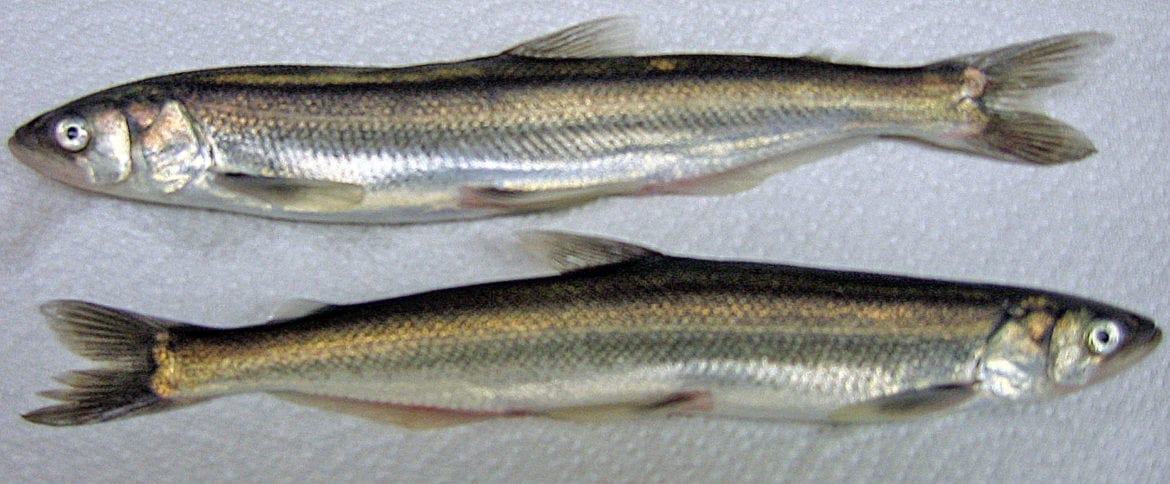 The next bait of the season which I usually fish from April until June is the Eulachon (Pronounced Oolagin). These are a type of smelt that come up the river each year to spawn and are the first feast of the year for the sturgeon. When breaking up this bait I basically sew the fish on the line. I start at the tail and go in and out through the body of the fish about three times.
The next bait of the season which I usually fish from April until June is the Eulachon (Pronounced Oolagin). These are a type of smelt that come up the river each year to spawn and are the first feast of the year for the sturgeon. When breaking up this bait I basically sew the fish on the line. I start at the tail and go in and out through the body of the fish about three times.
Then I put the hook in the top of the head so it comes out of the head pointing towards the tail. I then half hitch the tail with my leader. A braided leader works best for this application. I find that Eluachon's are such a major food source for the sturgeon that they will still work long after the run has ended.
Another good bait that I will use throughout the summer into fall is salmon meat. I will also use salmon parts such as heads and gills. When hooking these to the line I like a very simple system. I just take the hook and put it through the end of it and let it hang off the hook, nice and simple.
Now which salmon species to use as bait depends on many factors. Which salmon is in the river at the time and whether or not we can keep them. When available, I will use salmon meat from whichever salmon are in the river until the end of the season in November.
Now keep in mind this is a general guideline, although all of these baits will work throughout the season, different baits will work best at different times. You want to try and match what is available in the river at the time which will take a little bit of research on your part.
Fraser River Sturgeon Fishing Spots
Many people ask me what to look for when searching for a spot to fish for Sturgeon. Well there is no definitive answer to this question unfortunately. Many people believe that you need to fish in the deepest spots to catch sturgeon but this is only partially true. Although Sturgeon are often found in the deepest spots of the river, they are also everywhere in the river.
Sturgeon are constantly on the move, here today, gone tomorrow, so not all spots are good all the time. It's a constant game of cat-and-mouse, always searching for the fish. We often catch fish in less than 10 feet of water. Chances are that if it looks good, it is good at some point.
I prefer to look at the current. If the current has a nice even flow, then to me that looks like a good spot. I'll also look for shelves, drop offs, and flats. I tend to stay away from the swirly water, as it tends to blow your lines around which promotes tangles, and you always want your bait resting on the bottom.
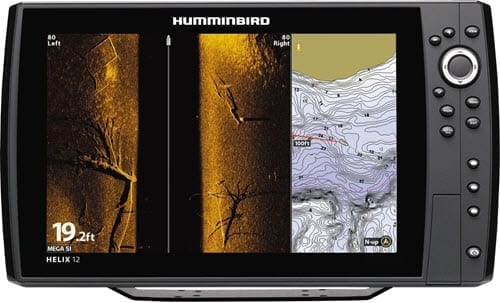 One of the keys these days to locating Sturgeon is a good fish finder, one that can see the sturgeon on the bottom. Look for a finder that has side imaging. It's the side imaging that will let you see the sturgeon laying on the bottom. Humminbird and Garmin are two of the top brands. First you look for the current, then you scan it and see if there's any fish laying there. Basically it's a lot of trial and error, but over time you will develop a pattern.
One of the keys these days to locating Sturgeon is a good fish finder, one that can see the sturgeon on the bottom. Look for a finder that has side imaging. It's the side imaging that will let you see the sturgeon laying on the bottom. Humminbird and Garmin are two of the top brands. First you look for the current, then you scan it and see if there's any fish laying there. Basically it's a lot of trial and error, but over time you will develop a pattern.
Once I find the sturgeon, I will position my boat above them, anchor, and cast my baits so that my bait lands upstream of the fish. I'm trying to create a scent trail that the sturgeon can follow. Now bear in mind, not all fish are biters. If a sturgeon is an active biter, and he smells your bait, you can expect a bite within the first 20 minutes. Moving around from spot to spot is the key to a successful day. The more fish you can present your bait to, the greater your chance of encountering active biters.
Once I drop the anchor, I give it 30 minutes max. If I haven't had a bite in that time, then I'm moving on in search of more fish. I find that one of the biggest mistakes that people make when Sturgeon fishing is waiting it out for too long. They see big fish on the screen and just want to sit there and wait for it to bite. Sturgeon can be notoriously fickle, know when to throw in the towel and move on.
Fraser River Sturgeon Fishing Report
You can check out our Sturgeon Fishing Report to get the latest fishing conditions on the Fraser River.
Fraser River Sturgeon Fishing Guide
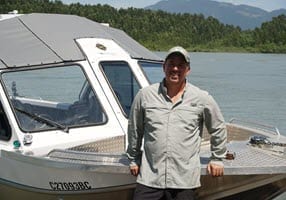 If you're new to sturgeon fishing, I hope this information helped get you ready to take on these river giants.
If you're new to sturgeon fishing, I hope this information helped get you ready to take on these river giants.
If you're at all unsure if you are ready to head out on your own we offer guided sturgeon fishing charters on the Fraser River where we take care of everything for you. In addition we have a FAQ that will answer any questions you may have about our fishing charter trips.
We'll use our 22 years of experience to get you on the fish and hooked up for the fight of your life!

